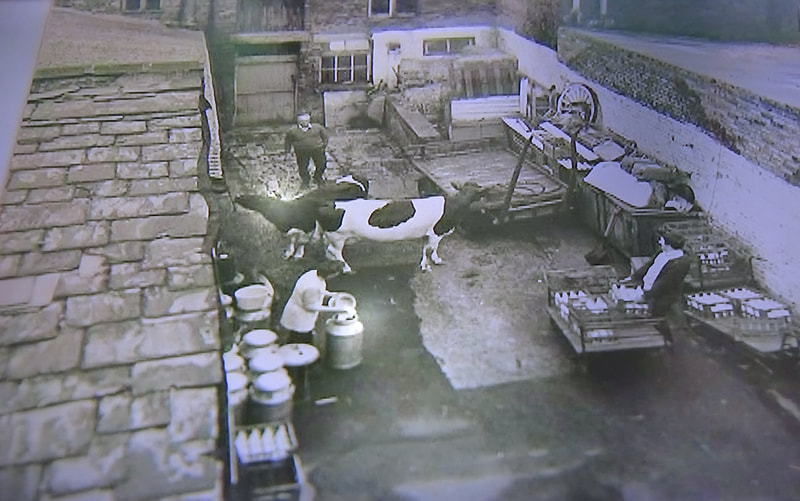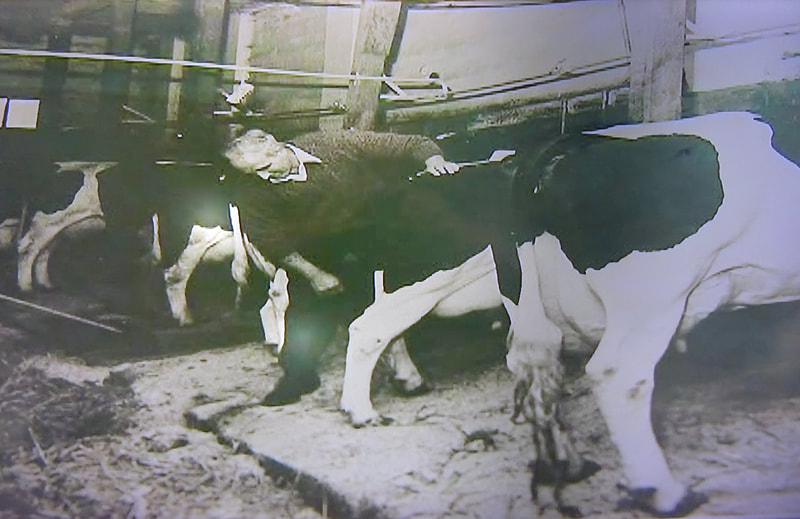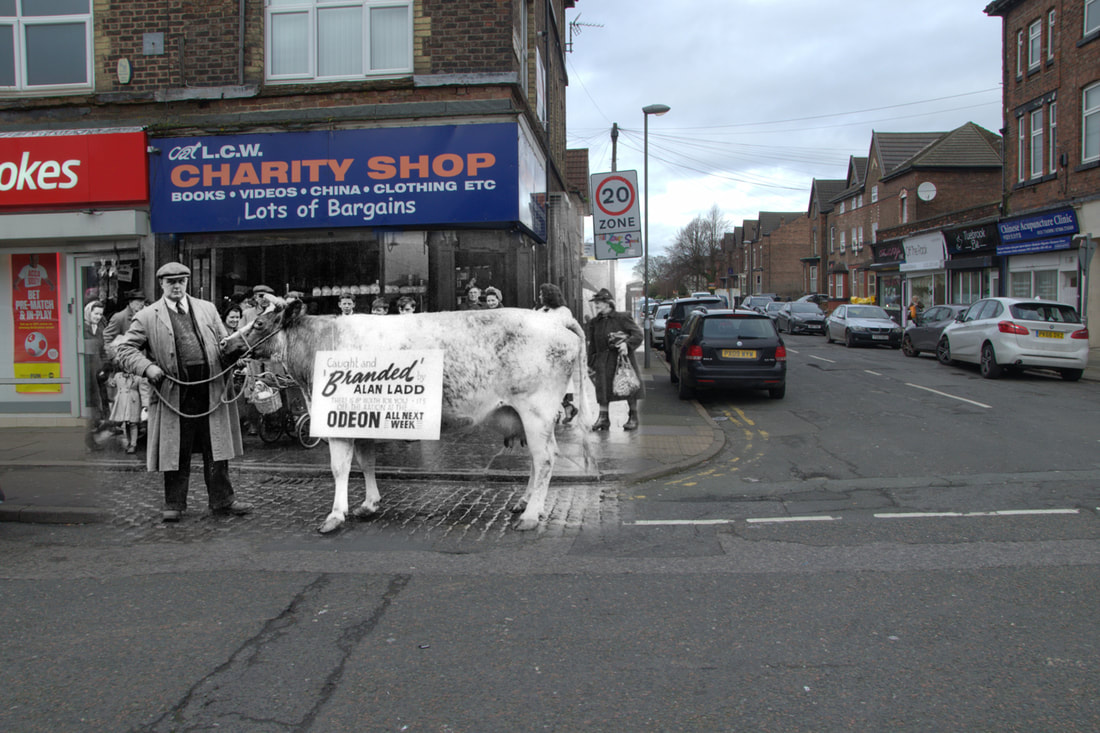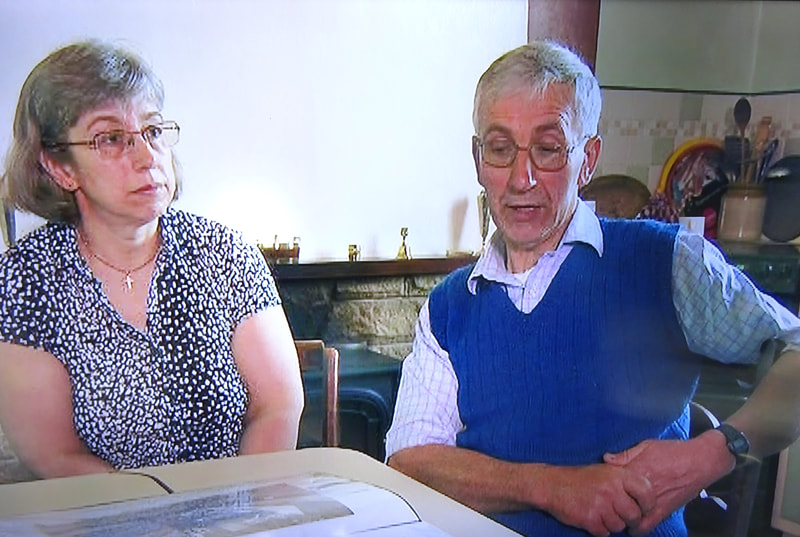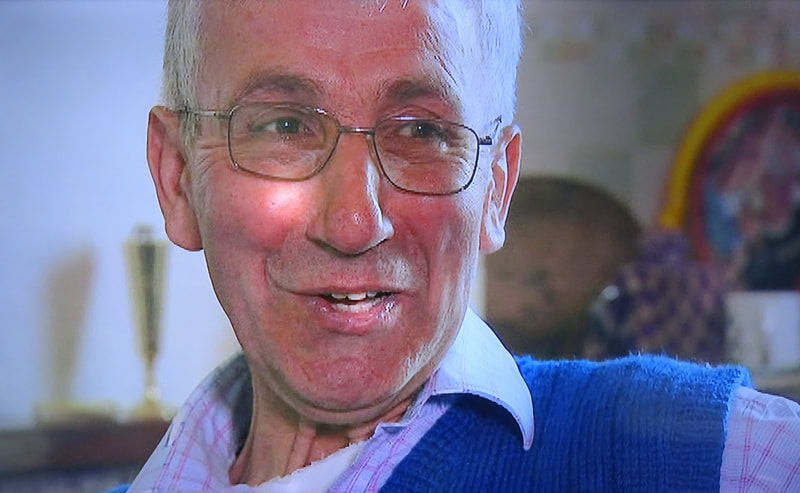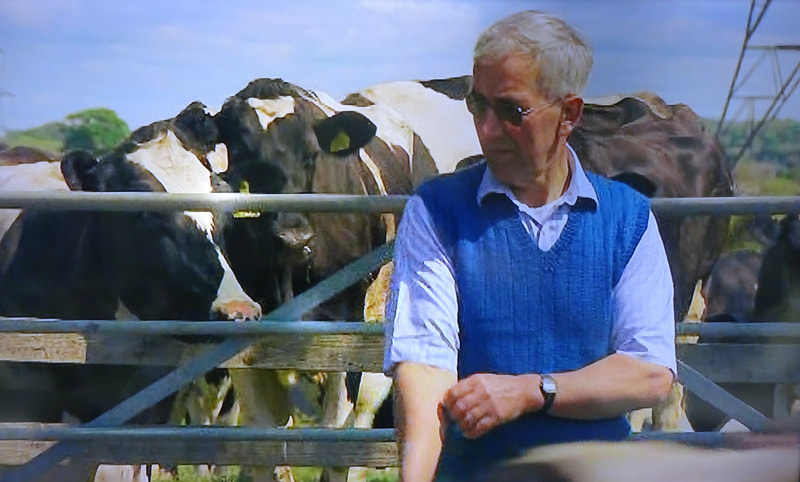Joe Capstick was the last Liverpool cowkeeper. Indeed, as far as I can ascertain, he was the last true city cowkeeper in the country. For some time I had resisted the temptation to research the Capstick family history as it had already been so eloquently captured by Duncan Scott in his self-published books: Urban Cowboys (2010) and Fields of Discovery (2016). However, when I received from author Jean Renwick an article taken from an old copy of the Farmers Guardian (sent to her by Joe Capstick's nephew, Keith Smith), I was prompted to revisit what additional information I had about the country’s last Cowkeeper and decided it was worth presenting here. So, here is a potted history of the Capstick family of Marlborough Road, together with transcripts from a couple of articles and a TV feature.
Joseph Capstick (1902-1968)
Joe’s father was John Bowman Capstick (1878-1949) who came from Howgill, near Sedbergh; he was one of ten children. On 14th April 1900 he married Annie Greenwood (1878-1940), from Cautley. They married in Liverpool and set up a dairy at 10 LEDWARD STREET, where John Bowman kept cows. (Joe was born there, in 1902). However, ten years later they were living at 16 Woodland Road, Cherry Lane, Walton, and John’s occupation was given as Farm Labourer — he worked on a farm in Wavertree, near Picton Clock. It wasn’t until 1921 that the family relocated to SANDY LANE FARM. Joe was 19 years old at the time, and was one of seven children: Margaret (b. 1901), Joseph (b. 1902), Miles (b. 1904), Janey (b. 1907), Annie (b. 1910), John (b. 1913) and Clara (b. 1915). All the Capstick children were involved in helping run the family business, learning all aspects of keeping cows and producing and delivering milk. Janey and Miles would continue the business after their father (see ‘The Capstick Family of Sandy Lane Farm’, elsewhere on this website).
In 1926, Joe married Alice Elizabeth Hilton (1901-1972), in Liverpool. They set up home at 416 Longmoor Lane, Fazakerley. This property was just down the road from Sandy Lane Farm, so Joe was able to continue working there. Joe and Alice had three children: Alice Elizabeth (b. 1927), Joseph Nicholson (b. 1928) and Margaret Rose (b. 1934).
In 1937, Joe heard that Edward Harper was looking for a new cowman at his dairy in Mossley Hill. The position came with accommodation in the form of Bower Cottage, attached to Bower House, on Rose Lane. The cellar at this property proved of to be of great use as a shelter for both the Capstick and the Harper families during the bombings of the Second World War. Seven years of living and working at MOSSLEY HILL DAIRY put Joe on a sound enough financial footing to be able to afford a dairy business of his own. In 1944 he acquired a dairy at 2-4 MARLBOROUGH ROAD, Tuebrook, which he bought from dairyman James Leck.
Joe’s father was John Bowman Capstick (1878-1949) who came from Howgill, near Sedbergh; he was one of ten children. On 14th April 1900 he married Annie Greenwood (1878-1940), from Cautley. They married in Liverpool and set up a dairy at 10 LEDWARD STREET, where John Bowman kept cows. (Joe was born there, in 1902). However, ten years later they were living at 16 Woodland Road, Cherry Lane, Walton, and John’s occupation was given as Farm Labourer — he worked on a farm in Wavertree, near Picton Clock. It wasn’t until 1921 that the family relocated to SANDY LANE FARM. Joe was 19 years old at the time, and was one of seven children: Margaret (b. 1901), Joseph (b. 1902), Miles (b. 1904), Janey (b. 1907), Annie (b. 1910), John (b. 1913) and Clara (b. 1915). All the Capstick children were involved in helping run the family business, learning all aspects of keeping cows and producing and delivering milk. Janey and Miles would continue the business after their father (see ‘The Capstick Family of Sandy Lane Farm’, elsewhere on this website).
In 1926, Joe married Alice Elizabeth Hilton (1901-1972), in Liverpool. They set up home at 416 Longmoor Lane, Fazakerley. This property was just down the road from Sandy Lane Farm, so Joe was able to continue working there. Joe and Alice had three children: Alice Elizabeth (b. 1927), Joseph Nicholson (b. 1928) and Margaret Rose (b. 1934).
In 1937, Joe heard that Edward Harper was looking for a new cowman at his dairy in Mossley Hill. The position came with accommodation in the form of Bower Cottage, attached to Bower House, on Rose Lane. The cellar at this property proved of to be of great use as a shelter for both the Capstick and the Harper families during the bombings of the Second World War. Seven years of living and working at MOSSLEY HILL DAIRY put Joe on a sound enough financial footing to be able to afford a dairy business of his own. In 1944 he acquired a dairy at 2-4 MARLBOROUGH ROAD, Tuebrook, which he bought from dairyman James Leck.
After the war, Liverpool Cowkeepers’ Association resumed its annual Christmas Show of fat and dairy cattle, and the Marlborough Road dairy exhibited many prize-winning beasts. On occasions, Joe found himself in competition with his siblings, Miles and Janey, who were still running Sandy Lane Farm, trading as J B Capstick & Son:
1946
Fat Cows not exceeding 13½cwt. 3rd Prize: J Capstick, Marlborough Road, Tuebrook.
1949
Open Class: Heifer, more than four broad teeth: J Capstick, Liverpool.
1950
Cow, calved, not exceeding 10cwt. 2nd Prize: J Capstick, Marlborough Road.
Pair of cows, one fat cow and one cow in milk. 2nd Prize: J Capstick.
Consolation Class. Fat cow, any weight. 1st Prize: J Capstick.
1951
Fat Cow, any weight, having not won a prize. 2nd Prize: J Capstick.
Cow, calved exceeding 11cwt. 2nd Prize: J Capstick.
Cow, calved not exceeding 10cwt. 2nd Prize: J B Capstick and Son, Fazakerley.
Cow in calf, black and white, any weight. 1st Prize: J Capstick.
Cow in calf other than black and white, any weight. 1st and 3rd Prize: J Capstick.
Pair of dairy cows in calf or milk. 3rd Prize: J Capstick.
Pair of cows, one fat cow and one dairy cow in milk.; 2nd Prize: J Capstick.
1952
Dairy Cow in calf. 2nd and 3rd Prize: J Capstick.
Heifer in calf, not more than four broad teeth. 1st Prize: J Capstick.
Dairy Heifer shown by boy or girl under 16 years of age. 2nd Prize: J Capstick.
1946
Fat Cows not exceeding 13½cwt. 3rd Prize: J Capstick, Marlborough Road, Tuebrook.
1949
Open Class: Heifer, more than four broad teeth: J Capstick, Liverpool.
1950
Cow, calved, not exceeding 10cwt. 2nd Prize: J Capstick, Marlborough Road.
Pair of cows, one fat cow and one cow in milk. 2nd Prize: J Capstick.
Consolation Class. Fat cow, any weight. 1st Prize: J Capstick.
1951
Fat Cow, any weight, having not won a prize. 2nd Prize: J Capstick.
Cow, calved exceeding 11cwt. 2nd Prize: J Capstick.
Cow, calved not exceeding 10cwt. 2nd Prize: J B Capstick and Son, Fazakerley.
Cow in calf, black and white, any weight. 1st Prize: J Capstick.
Cow in calf other than black and white, any weight. 1st and 3rd Prize: J Capstick.
Pair of dairy cows in calf or milk. 3rd Prize: J Capstick.
Pair of cows, one fat cow and one dairy cow in milk.; 2nd Prize: J Capstick.
1952
Dairy Cow in calf. 2nd and 3rd Prize: J Capstick.
Heifer in calf, not more than four broad teeth. 1st Prize: J Capstick.
Dairy Heifer shown by boy or girl under 16 years of age. 2nd Prize: J Capstick.
1952 was the last year the Liverpool Livestock Show included classes for dairy cattle. This was a reflection of the declining numbers of cows being kept in the city. It was a trend that Joe resisted as he was intent on passing the family business to the next generation. His children all married partners they had met at the Liverpool Young Farmer’s Club: in 1955, Joseph Nicholson married Nancy Holgate Cook; in 1957, Alice Elizabeth married William Harrison; and, in 1960, Margaret Rose married Gilbert Rowlands.
Once married, the two Capstick sisters left the city: Alice and William moved to a farm near Tarbock; Margaret and Gilbert moved to Old Hall Farm, near Thelwall. But, Joseph and Nancy stayed local. They moved into a property at 60 Buckingham Road; the next street along from Marlborough Road. This enabled Joseph to continue working the dairy with his father. While at Buckingham Road, they had three children: Linda Elizabeth (Betty) (b. 1956), Joseph Maurice (b. 1958), and Catherine Margaret (b. 1965).
Joe senior passed away in October 1968, at the age of 65. His son, Joe junior, then left Buckingham Road and relocated his family to the dairy at Marlborough Road to continue running the business. Joseph Nicholson Capstick became the next ‘Joe Capstick’; his son, Joseph Maurice Capstick, was known as Maurice (thereby avoiding any further confusion!).
The operation of the dairy at Marlborough Road is described with some interesting detail in two articles from 1969 and 1975, respectively.
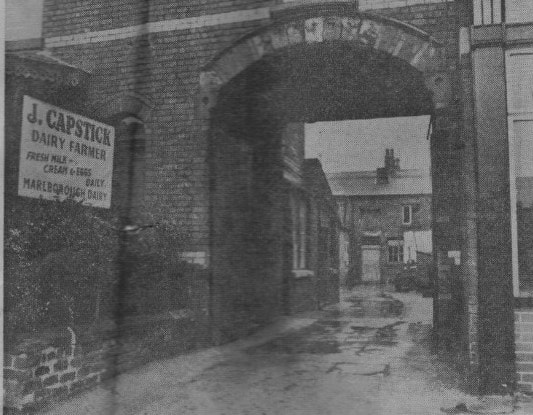
One of the Last of the City Cowkeepers — Milk in the Towns
Farmers’ Guardian 1969
At one time there were many hundreds of cowkeepers in Liverpool — men who produced milk from cows kept in the heart of a city — but now there are only three. One of them is Mr Joe Capstick whose trading sign in a side street in Tuebrook, Liverpool 13, proudly proclaims “ J Capstick, Dairy Farmer.”
Mr Capstick has been farming in Tuebrook for a quarter of a century and at one time milked up to 28 cows. At that time he was running the business with his father who died only recently. Mr Capstick recalls the Christmas dairy shows which were held in Liverpool. They encouraged keen competition among the cowkeepers and were famous for the quality of stock, which was brought there from a wide area. The Capsticks showed regularly and won the milking trials twice with a Shorthorn cow. A win at the dairy show attracted publicity and was often a boost to trade for the winner.
The Capsticks went out of Shorthorns many years ago and the milk now comes from 10 to 12 black and white cows which are kept on for one lactation only.
After the war it became difficult for cowkeepers to find labour and Mr Capstick has a unit, which he can manage comfortably on his own. He either buys replacement stock himself at Lancaster or a breeder obtains stock for him. Cows are milked and then usually beefed and sold either live at Preston or sent to a deadweight centre in Liverpool.
The cattle are housed in a bright airy shippon at the back of his house in Marlborough Road and are milked with two units. The milkers are maintained on hay and brewers’ grains, which are delivered from a Liverpool brewery. Mr Capstick’s brother-in-law, Mr Bill Harrison, who is an arable farmer at Tarbock, supplies him with regular deliveries of hay. During the summer period the cows also eat freshly cut grass clippings from playing fields. This is cut by the authority responsible and left in heaps for Mr Capstick to collect. Cutting goes on every day, as long as conditions are suitable, and the men who cut it make it easier for Mr Capstick to get a steady supply of freshly cut material by cutting bits of the area at a time. Mr Capstick picks up the grass the same day as it is cut and loads it on to his truck by using two boards; he bags the grass and one bagful is shared between two cows. Mr Capstick brings in as many as 20 bags a day.
He retails about 200 gallons of milk a day on a ‘block’ arrangement with Hansons dairies and the milk from his own cows goes to the dairies for pasteurisation. He also has a small shop at his premises where people can come and collect milk. He covers the retail round with a horse-drawn vehicle as well as the truck. Muck is collected every two days and he delivers and sells it to local allotment holders. Mr Capstick has three children and his young son Maurice who helps to look after the cattle, has a keen interest in show poultry. This year his birds will be shown at Otley and Chester.
Farmers’ Guardian 1969
At one time there were many hundreds of cowkeepers in Liverpool — men who produced milk from cows kept in the heart of a city — but now there are only three. One of them is Mr Joe Capstick whose trading sign in a side street in Tuebrook, Liverpool 13, proudly proclaims “ J Capstick, Dairy Farmer.”
Mr Capstick has been farming in Tuebrook for a quarter of a century and at one time milked up to 28 cows. At that time he was running the business with his father who died only recently. Mr Capstick recalls the Christmas dairy shows which were held in Liverpool. They encouraged keen competition among the cowkeepers and were famous for the quality of stock, which was brought there from a wide area. The Capsticks showed regularly and won the milking trials twice with a Shorthorn cow. A win at the dairy show attracted publicity and was often a boost to trade for the winner.
The Capsticks went out of Shorthorns many years ago and the milk now comes from 10 to 12 black and white cows which are kept on for one lactation only.
After the war it became difficult for cowkeepers to find labour and Mr Capstick has a unit, which he can manage comfortably on his own. He either buys replacement stock himself at Lancaster or a breeder obtains stock for him. Cows are milked and then usually beefed and sold either live at Preston or sent to a deadweight centre in Liverpool.
The cattle are housed in a bright airy shippon at the back of his house in Marlborough Road and are milked with two units. The milkers are maintained on hay and brewers’ grains, which are delivered from a Liverpool brewery. Mr Capstick’s brother-in-law, Mr Bill Harrison, who is an arable farmer at Tarbock, supplies him with regular deliveries of hay. During the summer period the cows also eat freshly cut grass clippings from playing fields. This is cut by the authority responsible and left in heaps for Mr Capstick to collect. Cutting goes on every day, as long as conditions are suitable, and the men who cut it make it easier for Mr Capstick to get a steady supply of freshly cut material by cutting bits of the area at a time. Mr Capstick picks up the grass the same day as it is cut and loads it on to his truck by using two boards; he bags the grass and one bagful is shared between two cows. Mr Capstick brings in as many as 20 bags a day.
He retails about 200 gallons of milk a day on a ‘block’ arrangement with Hansons dairies and the milk from his own cows goes to the dairies for pasteurisation. He also has a small shop at his premises where people can come and collect milk. He covers the retail round with a horse-drawn vehicle as well as the truck. Muck is collected every two days and he delivers and sells it to local allotment holders. Mr Capstick has three children and his young son Maurice who helps to look after the cattle, has a keen interest in show poultry. This year his birds will be shown at Otley and Chester.
JOE AND SON ARE THE CREAM OF THE PINTA MEN
Liverpool Echo — 28th January 1975
At one time in the early part of this century there were no fewer than 900 cowkeepers in Liverpool. All the trappings of rural life were carried on in backyard shippons housing anything between 10 and 30 cows. After the Second World War there were still 200 registered cowkeepers on the city's books. Now there is only one — Joe Capstick, who has his premises in Marlborough Road, Tuebrook, where his shippon accommodates 14 fine-looking Friesians, complacently chewing the cud on their beds of sawdust and providing a sizeable part of the area with its daily milk, delivered by horse-drawn lorry. Except on Sunday mornings when Bonny, the horse, has her weekly lie-in and the milk goes out on floats. What I found fascinating when I looked in on Joe's spick-and-span shippons, which have won him praise from the Milk Marketing Board, is that he won't be the last of the line.
In an age when no job is too sophisticated but many are too humdrum for the rising generation, Joe is fortunate in having a son, Maurice, who wants nothing more than to carry on a business that was set up in Marlborough Road by his grandfather. His forebears had farmed in Sandy Lane. Maurice, who told me he is sixteen going on seventeen, can do every job there is around the dairy and the shippons, but his greatest joy is delivering the milk with the aid of Bonny. "She knows every customer," he told me. "The moment she leaves the yard she goes tearing off to Lisburn Lane, where she gets her first tit-bit from a customer. Then it's a gentle plod, stopping at every customer's door until it's time to speed up to the next for bit of sugar or biscuit." And that seemed to be the tempo of life in that Marlborough Road yard, although just around the corner in West Derby Road, city life went racing on.
Liverpool Echo — 28th January 1975
At one time in the early part of this century there were no fewer than 900 cowkeepers in Liverpool. All the trappings of rural life were carried on in backyard shippons housing anything between 10 and 30 cows. After the Second World War there were still 200 registered cowkeepers on the city's books. Now there is only one — Joe Capstick, who has his premises in Marlborough Road, Tuebrook, where his shippon accommodates 14 fine-looking Friesians, complacently chewing the cud on their beds of sawdust and providing a sizeable part of the area with its daily milk, delivered by horse-drawn lorry. Except on Sunday mornings when Bonny, the horse, has her weekly lie-in and the milk goes out on floats. What I found fascinating when I looked in on Joe's spick-and-span shippons, which have won him praise from the Milk Marketing Board, is that he won't be the last of the line.
In an age when no job is too sophisticated but many are too humdrum for the rising generation, Joe is fortunate in having a son, Maurice, who wants nothing more than to carry on a business that was set up in Marlborough Road by his grandfather. His forebears had farmed in Sandy Lane. Maurice, who told me he is sixteen going on seventeen, can do every job there is around the dairy and the shippons, but his greatest joy is delivering the milk with the aid of Bonny. "She knows every customer," he told me. "The moment she leaves the yard she goes tearing off to Lisburn Lane, where she gets her first tit-bit from a customer. Then it's a gentle plod, stopping at every customer's door until it's time to speed up to the next for bit of sugar or biscuit." And that seemed to be the tempo of life in that Marlborough Road yard, although just around the corner in West Derby Road, city life went racing on.
"Leaving of the Cows"
(Visit the British Film Institute website – https://player.bfi.org.uk/free/film/watch-leaving-of-the-cows-1975-online)
It had always been the intention of Joe Capstick to one day have his own dairy farm in the countryside. That aim was fulfilled in August 1975, when he acquired Brantbeck Farm, just south of Lancaster. The day the Capsticks and their cows moved out of the city, was captured on film by Joe’s eldest daughter, Betty, using a hand-held cine camera.
Some forty years later, that same colour cine footage was discovered by the British Film Institute (BFI) and was recognised as being a unique visual record of Liverpool’s last cowkeeper leaving the city. The launch of that footage — titled “Leaving of the Cows” — on the BFI website was reported by the BBC’s North West Tonight news programme on the evening of Wednesday 25th May 2016. The report included clips from the cine footage, and Capstick siblings Maurice and Catherine being interviewed by reporter Stuart Flinders:
Studio introduction: "Home movies from the 1970s have emerged, which show an aspect of how different life was here just 40 years ago. Back then, some dairy cows were still being kept in the heart of our city providing fresh milk to urban communities. The British Film Institute has found some footage, which shows one of those inner city dairies being closed down. Stuart Flinders has been to meet one of Liverpool’s last cowkeepers."
Stuart (standing outside 2-4 Marlborough Road): “This isn’t a farmyard in the heart of the countryside — this is the big city. This is where those pictures were filmed, right next to one of the busiest main roads into Liverpool, in West Derby. It’s a block of flats now and I guess the people who live here may have a cat or a dog — but, cows?
In the days before refrigeration milk didn’t stay fresh for long. So, every neighbourhood had a dairy with real, live cows. This was Liverpool’s last, and in August 1975, the cows finally moved out. It was the day Maurice Capstick and his sister Catherine moved out too."
Stuart (viewing cine footage with Catherine and Maurice): "It was a bit of the countryside in the town and was a different kind of farming. This was the view from Maurice’s bedroom. The only time the cows saw a blade of grass was when it was brought to them.”
Maurice: “We would get grass from some local school playing fields and we did occasionally get grass from Everton’s training ground, off Eaton Road.”
Stuart: “So the Everton players would be training on the pitch one day, and the next day the grass would be sent to your cows.”
Maurice: “Yes. That’s recycling, Stuart!”
Stuart: “Some of the cows were reluctant to leave, but they were moving to a place in the country. The family had bought a farm, near Lancaster. ‘Grass!’, they’re thinking. ‘What’s this?’"
Maurice: “They soon found out what to do with it! It was a complete turnaround coming up here.”
Stuart: “What’s happened to your Scouse accent?”
Maurice: “It comes out when I swear, Stuart!”
Stuart: “A happy ending for Liverpool’s last cows and for its last Cowkeepers. Maurice and Catherine are still farming in Lancashire.”
(Visit the British Film Institute website – https://player.bfi.org.uk/free/film/watch-leaving-of-the-cows-1975-online)
It had always been the intention of Joe Capstick to one day have his own dairy farm in the countryside. That aim was fulfilled in August 1975, when he acquired Brantbeck Farm, just south of Lancaster. The day the Capsticks and their cows moved out of the city, was captured on film by Joe’s eldest daughter, Betty, using a hand-held cine camera.
Some forty years later, that same colour cine footage was discovered by the British Film Institute (BFI) and was recognised as being a unique visual record of Liverpool’s last cowkeeper leaving the city. The launch of that footage — titled “Leaving of the Cows” — on the BFI website was reported by the BBC’s North West Tonight news programme on the evening of Wednesday 25th May 2016. The report included clips from the cine footage, and Capstick siblings Maurice and Catherine being interviewed by reporter Stuart Flinders:
Studio introduction: "Home movies from the 1970s have emerged, which show an aspect of how different life was here just 40 years ago. Back then, some dairy cows were still being kept in the heart of our city providing fresh milk to urban communities. The British Film Institute has found some footage, which shows one of those inner city dairies being closed down. Stuart Flinders has been to meet one of Liverpool’s last cowkeepers."
Stuart (standing outside 2-4 Marlborough Road): “This isn’t a farmyard in the heart of the countryside — this is the big city. This is where those pictures were filmed, right next to one of the busiest main roads into Liverpool, in West Derby. It’s a block of flats now and I guess the people who live here may have a cat or a dog — but, cows?
In the days before refrigeration milk didn’t stay fresh for long. So, every neighbourhood had a dairy with real, live cows. This was Liverpool’s last, and in August 1975, the cows finally moved out. It was the day Maurice Capstick and his sister Catherine moved out too."
Stuart (viewing cine footage with Catherine and Maurice): "It was a bit of the countryside in the town and was a different kind of farming. This was the view from Maurice’s bedroom. The only time the cows saw a blade of grass was when it was brought to them.”
Maurice: “We would get grass from some local school playing fields and we did occasionally get grass from Everton’s training ground, off Eaton Road.”
Stuart: “So the Everton players would be training on the pitch one day, and the next day the grass would be sent to your cows.”
Maurice: “Yes. That’s recycling, Stuart!”
Stuart: “Some of the cows were reluctant to leave, but they were moving to a place in the country. The family had bought a farm, near Lancaster. ‘Grass!’, they’re thinking. ‘What’s this?’"
Maurice: “They soon found out what to do with it! It was a complete turnaround coming up here.”
Stuart: “What’s happened to your Scouse accent?”
Maurice: “It comes out when I swear, Stuart!”
Stuart: “A happy ending for Liverpool’s last cows and for its last Cowkeepers. Maurice and Catherine are still farming in Lancashire.”
Footnote: The Capstick Sisters
In my illustrated talk, Liverpool Cowkeepers — A Family History, I always conclude by making the point that although the Joys were one of the last cowkeeping families in Liverpool, they weren’t the last — that honour goes to Joe Capstick and his family. I illustrate this point with a ‘still’ taken from the cine footage and refer people to the BFI website to view the full version for themselves. It was back in April 2017 that I gave a talk to Lancaster and District Family History Group. After the talk I was approached by two smiling ladies, who introduced themselves: “We’re the Capstick sisters!” They told me their brother, Maurice, was still farming near Lancaster and that they were delighted that I had mentioned their family in my talk. I was equally delighted to have made their acquaintance.
